UPSTATE NEW YORK SUISEKI STUDY GROUP JUNE MEETING
5 posters
Page 1 of 1
 UPSTATE NEW YORK SUISEKI STUDY GROUP JUNE MEETING
UPSTATE NEW YORK SUISEKI STUDY GROUP JUNE MEETING
This afternoon the Upstate New York Suiseki Study Group had another meeting. Peter Warren was in town translating for Kunio Kobayashi at the US National Bonsai Exhibition and also for a special “Advanced Bonsai Techniques & Bonsai Display Seminar” held all day on Monday and Tuesday. Peter studied with Mr. Kobayashi at his Shunka-en Bonsai Museum in Tokyo, Japan for six years and is now establishing his business in England. He came to translate and teach us.
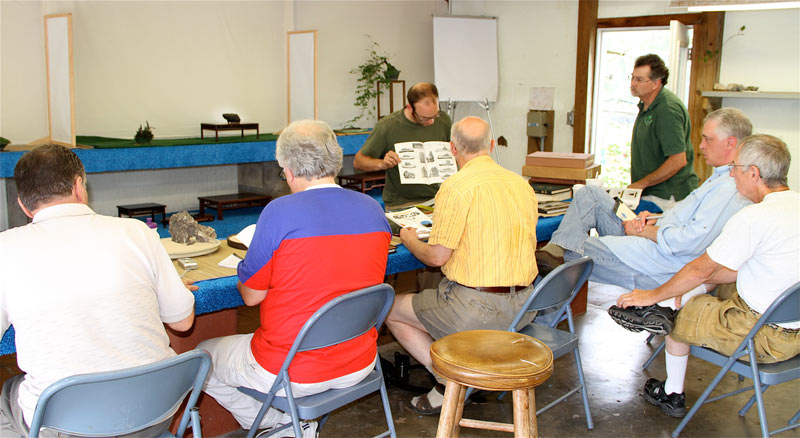
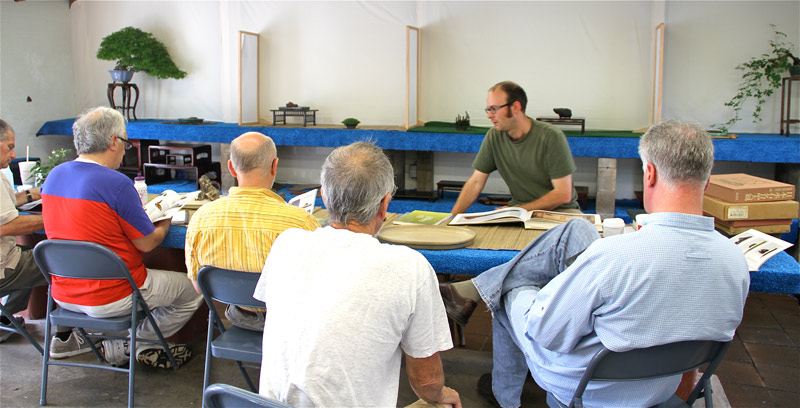
Since this is the beginning of summer Peter explained the differences between suiban suiseki and daiza suiseki. He showed many examples from my reference library of suiseki books and magazines. We were asked to select good and poor examples of bonsai displayed in suiban.
Next Peter moistened a stone and we all watched it dry out. (similar to watching grass grow?) The patterns created evoked mystery and other emotions. Today was very warm (for Rochester, NY) and the temperature reached over 90F. It was quite humid and the drying out of the suiseki created sort of a cool feeling. In fact, before the group assembled in my garden studio I watered the cement floor and other cement block tables three times so they would create a “welcome and cool” feeling and add to the ambience of the meeting. Suddenly a fresh breeze came which refreshed us all and then the rain arrived. It was wonderful to hear the sound of the rain drops on the roof which also added to our meeting. I did not need to water my bonsai today, but I had already watered the shohin bonsai and bushy deciduous bonsai earlier in the morning after moistening the studio classroom.
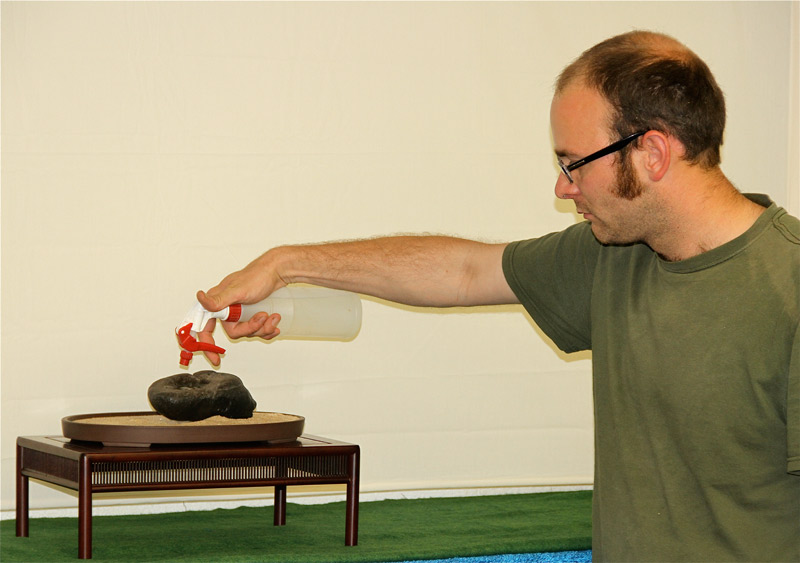
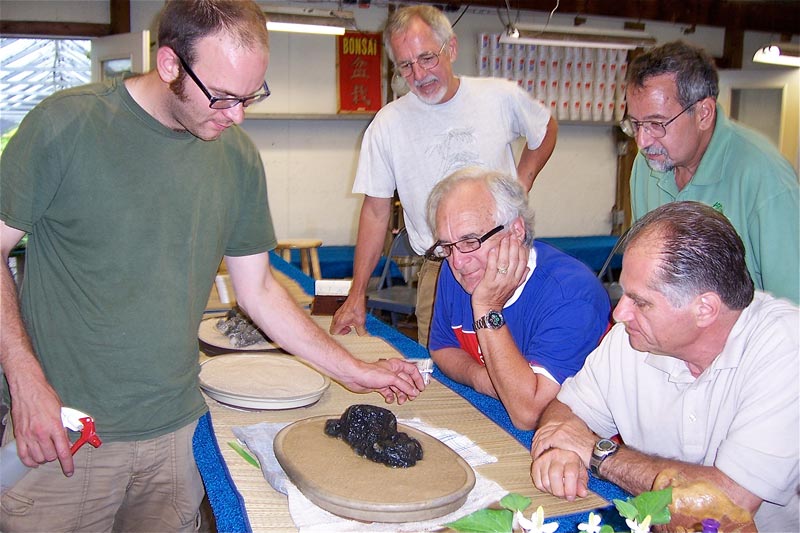
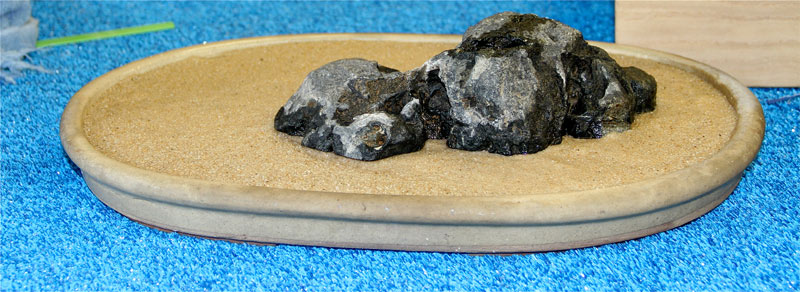
Peter then proceeded to show us how to fill suiban with sand and how to water in the sand. Then carefully the suiseki was positioned and watered again a couple of times. Before the group arrived prepared several display alcoves, some with blue carpet, tatami grass mat and green felt each to create a different summer feeling.
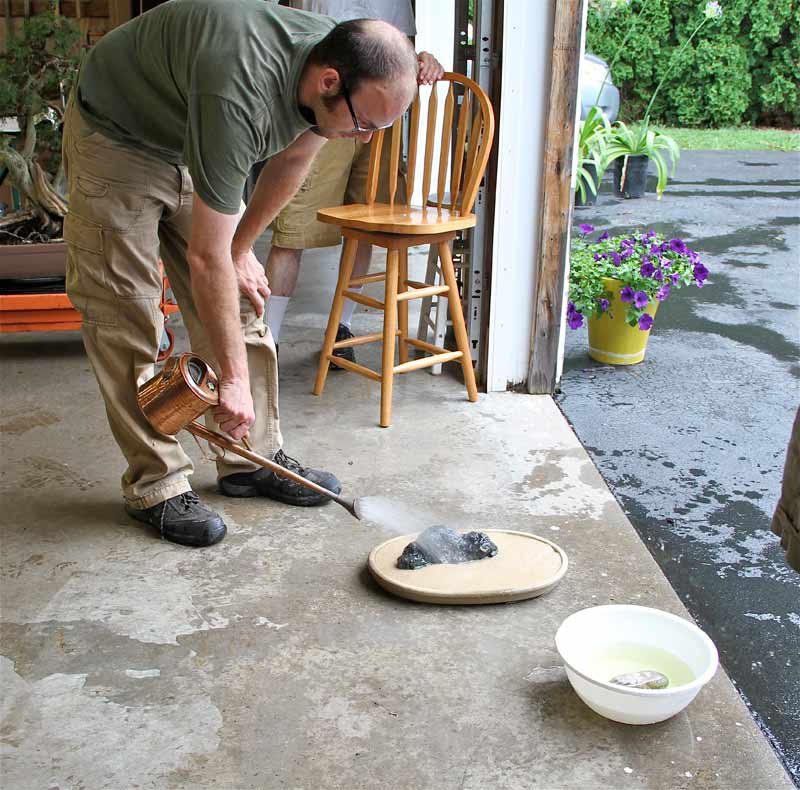
We discussed several different display options after Peter showed us his personal favorite. This was very interesting because all of our members had just successfully completed the Kobayashi Advanced Bonsai Techniques & Display Seminar. The basics Mr. Kobayashi taught us were put to test here. Several of our members set up individual suiseki displays in suiban and we all discussed their design and changed them too. Members were welcome to use my display tables and accessories as well as hanging scrolls. Peter had a bit of a difficult time selecting an appropriate scroll painting to display with the quiet suiseki displays. He also kept running into my office to retrieve display tables suitable for suiban suiseki display.
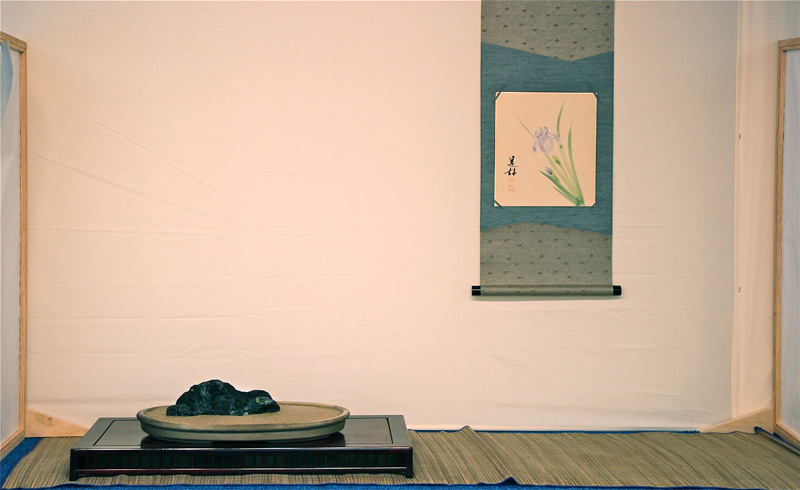
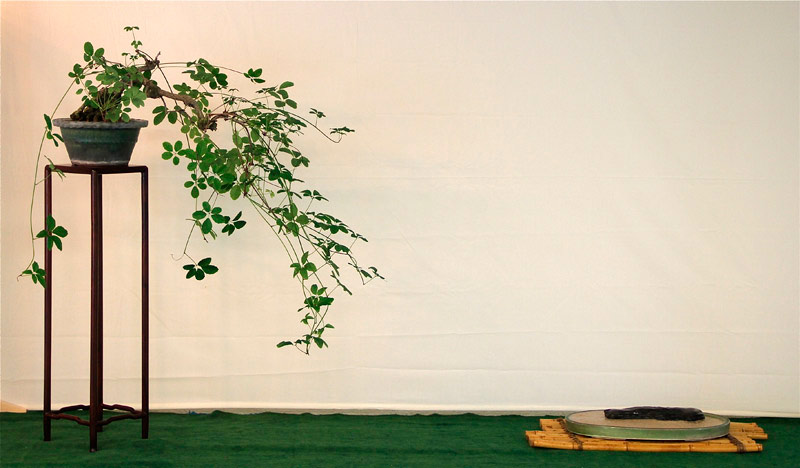
This was a very enjoyable and educational meeting following the busy US National Bonsai Exhibition. All of our study group members were also on the US National Bonsai Exhibition committee and worked very hard for 4 days which were followed by Kobayashi’s intense two day seminar. We all relaxed and enjoyed each other’s company while learning from a gifted and knowledgeable teacher Peter Warren. It’s important to take the time to enjoy and appreciate suiseki, while watching them dry out.
We are now looking for our next speaker for the Upstate New York Suiseki Study Group.
Bill


Since this is the beginning of summer Peter explained the differences between suiban suiseki and daiza suiseki. He showed many examples from my reference library of suiseki books and magazines. We were asked to select good and poor examples of bonsai displayed in suiban.
Next Peter moistened a stone and we all watched it dry out. (similar to watching grass grow?) The patterns created evoked mystery and other emotions. Today was very warm (for Rochester, NY) and the temperature reached over 90F. It was quite humid and the drying out of the suiseki created sort of a cool feeling. In fact, before the group assembled in my garden studio I watered the cement floor and other cement block tables three times so they would create a “welcome and cool” feeling and add to the ambience of the meeting. Suddenly a fresh breeze came which refreshed us all and then the rain arrived. It was wonderful to hear the sound of the rain drops on the roof which also added to our meeting. I did not need to water my bonsai today, but I had already watered the shohin bonsai and bushy deciduous bonsai earlier in the morning after moistening the studio classroom.



Peter then proceeded to show us how to fill suiban with sand and how to water in the sand. Then carefully the suiseki was positioned and watered again a couple of times. Before the group arrived prepared several display alcoves, some with blue carpet, tatami grass mat and green felt each to create a different summer feeling.

We discussed several different display options after Peter showed us his personal favorite. This was very interesting because all of our members had just successfully completed the Kobayashi Advanced Bonsai Techniques & Display Seminar. The basics Mr. Kobayashi taught us were put to test here. Several of our members set up individual suiseki displays in suiban and we all discussed their design and changed them too. Members were welcome to use my display tables and accessories as well as hanging scrolls. Peter had a bit of a difficult time selecting an appropriate scroll painting to display with the quiet suiseki displays. He also kept running into my office to retrieve display tables suitable for suiban suiseki display.


This was a very enjoyable and educational meeting following the busy US National Bonsai Exhibition. All of our study group members were also on the US National Bonsai Exhibition committee and worked very hard for 4 days which were followed by Kobayashi’s intense two day seminar. We all relaxed and enjoyed each other’s company while learning from a gifted and knowledgeable teacher Peter Warren. It’s important to take the time to enjoy and appreciate suiseki, while watching them dry out.
We are now looking for our next speaker for the Upstate New York Suiseki Study Group.
Bill

William N. Valavanis- Member
 UPSTATE NEW YORK SUISEKI STUDY GROUP JUNE MEETING
UPSTATE NEW YORK SUISEKI STUDY GROUP JUNE MEETING
You are so fortunate to have study group and have speakers like Peter Warren to teach you. More power to your group!

Ka Pabling- Member
 Re: UPSTATE NEW YORK SUISEKI STUDY GROUP JUNE MEETING
Re: UPSTATE NEW YORK SUISEKI STUDY GROUP JUNE MEETING
Hi Friends ,
I ' ve seen :
_ Satisfaction appeared on the faces of the students ...
_The stone that lay in the suiban express the full beauty of a Suiseki .
Thank for WILLIAM N. VALAVANIS ' s post .
I ' ve seen :
_ Satisfaction appeared on the faces of the students ...
_The stone that lay in the suiban express the full beauty of a Suiseki .
Thank for WILLIAM N. VALAVANIS ' s post .
trantanhung_nt- Member
 Re: UPSTATE NEW YORK SUISEKI STUDY GROUP JUNE MEETING
Re: UPSTATE NEW YORK SUISEKI STUDY GROUP JUNE MEETING
Hi Bill... Thanks for sharing. About two weeks before the National Exhibition, I had planned to go in order to see Kunio Kobayashi & Peter as well as you, Mark and the bonsai, but a surprise medical condition for Susan changed my priority. I'm glad the suiseki group had the opportunity of Peter's advice & look forward to hearing more from him at the International Stone Appreciation Symposium (Hershey PA USA) in late September.
RE’ illustration:
At one tatami mat's length, was Peter expressing an intimate alcove setting or an exhibition setting? It would be cramped compared to reception room alcoves (as at at Kunio Kobayashi's & Uhaku Sudo's studio gardens), but about the size of an alcove in Kobayashi's studio tea-room emulating a tea hut. In stone exhibitions, matching individual stones to scrolls in wabi-style is less common than showing the stones alone but, still, common enough to express some discipline & especially to suggest boundless space.
The painting of an iris on a hanging scroll is formally displayed to represent Boys Day on May 5th, but with the less-formal suiseki in a suiban, it's reasonably seen more broadly as the plant blooming in nature in the late spring season.
Did Peter choose the display as illustrated or recommend changes? While the flower leans leftward, it appears that the tallest leaves of the iris (indicative of sword blades for Boys Day) have caught a breeze moving toward the right. It is often the less obvious but still discernable movement which determines the placement of the scroll relative to the principal object of display. Sudo noted the palest reflection of the moon in water under a moon in the sky as the element which drives eye movement for the discerning viewer-- I'll try to locate a photo.
Significantly, the signature & hanko "stamp" of the artist are together very dominant on the left side of the board displaying the iris. While a less dominant signature & hanko would typically not effect viewing, this example boldly interrupts the viewer's glance which should fill the scene among objects displayed without that distraction.
Exhibition display (especially when mixed with bonsai display) is likely much freer than intimate alcove display. In Japan, Sudo noted Keido practice was not practice for exhibit display. Sudo's "master" student Fumio Kobayashi repeated when lecturing at the National Bonsai & Penjing Museum (Washington DC USA) that alcove & exhibit display are not the same and decried shohin bonsai display as very confused (for his taste). Peter's teacher Kunio Kobayashi teaches shohin display distinctly different from typical displays seen at the Gafuten or Kokufuten, though he has also been awarded for shohin display at the Gafuten, which is the premiere exhibition of the All-Japan Shohin Bonsai Association.
It seems there is considerable variety in Japanese display discipline which will always be a little confounding to the viewer expecting one clear path of understanding. That has been the clear message from posts by Wil on California Aiseki Kai newsletters. Peter has been taught by Kunio Kobayashi & accepts his authority as a teacher. Kobayashi as well as other teachers don't demand slavish repetition from their students, however, and instead encourage creative expression.
Peter's personal expression can be very creative as seen in his writing and display. On the other hand, he knows discipline. Managing under personally cultivated discipline seems the goal-- not mimicking others' style. I once questioned Peter for his style in mounting an exhibit of bonsai pots. I teased him that he was using the “Thin, Red-Line Style” mimicking English soldiers standing at regular intervals. Peter responded that he had limited room to display a number of pots, and added that as long as he was doing his best it was a successful attempt. He repeated often to do your best as you can’t do better when working on bonsai. I do not know if that came from his personal experience or if the seed was sown from Kobayashi. It suggested some horse-sense (practicality) that would seem the opposite of guidance by authority. It is worth considering before questioning any display arrangement.
Kunio Kobayashi is particularly notable for having a huge variety of implements at his disposal for creating the display he desires. I've seen him use less than ideal implements in creative ways to prepare exhibits for an important audience (Japanese TV) and wondered at the choice. Perhaps, this is more indicative of life-- making do with what you have with considerable allowance for less-than-ideal. A fully acceptable display arrangement is as likely (perhaps, more likely) to arise from an open attitude of guests & the host (a social decision) rather than from perfected arrangement (an artistic decision). This has deep resonance for host-guest appreciation in tea ceremony, which has extremely guided ritual.
With humility, a viewer should respect the host/artist arrangement even if it confuses. Appreciate feeling for nature as well as for the host & gathered guests. If display is presented for learning through discussion, deconstruction is the Western model for evaluating its discipline. In Japan, the Keido method of instruction is ‘listening’ for feeling- listening with senses that are not only auditory but include sight, touch, smell, taste (often one sense referenced using another) & imagination.
RE’ illustration:
At one tatami mat's length, was Peter expressing an intimate alcove setting or an exhibition setting? It would be cramped compared to reception room alcoves (as at at Kunio Kobayashi's & Uhaku Sudo's studio gardens), but about the size of an alcove in Kobayashi's studio tea-room emulating a tea hut. In stone exhibitions, matching individual stones to scrolls in wabi-style is less common than showing the stones alone but, still, common enough to express some discipline & especially to suggest boundless space.
The painting of an iris on a hanging scroll is formally displayed to represent Boys Day on May 5th, but with the less-formal suiseki in a suiban, it's reasonably seen more broadly as the plant blooming in nature in the late spring season.
Did Peter choose the display as illustrated or recommend changes? While the flower leans leftward, it appears that the tallest leaves of the iris (indicative of sword blades for Boys Day) have caught a breeze moving toward the right. It is often the less obvious but still discernable movement which determines the placement of the scroll relative to the principal object of display. Sudo noted the palest reflection of the moon in water under a moon in the sky as the element which drives eye movement for the discerning viewer-- I'll try to locate a photo.
Significantly, the signature & hanko "stamp" of the artist are together very dominant on the left side of the board displaying the iris. While a less dominant signature & hanko would typically not effect viewing, this example boldly interrupts the viewer's glance which should fill the scene among objects displayed without that distraction.
Exhibition display (especially when mixed with bonsai display) is likely much freer than intimate alcove display. In Japan, Sudo noted Keido practice was not practice for exhibit display. Sudo's "master" student Fumio Kobayashi repeated when lecturing at the National Bonsai & Penjing Museum (Washington DC USA) that alcove & exhibit display are not the same and decried shohin bonsai display as very confused (for his taste). Peter's teacher Kunio Kobayashi teaches shohin display distinctly different from typical displays seen at the Gafuten or Kokufuten, though he has also been awarded for shohin display at the Gafuten, which is the premiere exhibition of the All-Japan Shohin Bonsai Association.
It seems there is considerable variety in Japanese display discipline which will always be a little confounding to the viewer expecting one clear path of understanding. That has been the clear message from posts by Wil on California Aiseki Kai newsletters. Peter has been taught by Kunio Kobayashi & accepts his authority as a teacher. Kobayashi as well as other teachers don't demand slavish repetition from their students, however, and instead encourage creative expression.
Peter's personal expression can be very creative as seen in his writing and display. On the other hand, he knows discipline. Managing under personally cultivated discipline seems the goal-- not mimicking others' style. I once questioned Peter for his style in mounting an exhibit of bonsai pots. I teased him that he was using the “Thin, Red-Line Style” mimicking English soldiers standing at regular intervals. Peter responded that he had limited room to display a number of pots, and added that as long as he was doing his best it was a successful attempt. He repeated often to do your best as you can’t do better when working on bonsai. I do not know if that came from his personal experience or if the seed was sown from Kobayashi. It suggested some horse-sense (practicality) that would seem the opposite of guidance by authority. It is worth considering before questioning any display arrangement.
Kunio Kobayashi is particularly notable for having a huge variety of implements at his disposal for creating the display he desires. I've seen him use less than ideal implements in creative ways to prepare exhibits for an important audience (Japanese TV) and wondered at the choice. Perhaps, this is more indicative of life-- making do with what you have with considerable allowance for less-than-ideal. A fully acceptable display arrangement is as likely (perhaps, more likely) to arise from an open attitude of guests & the host (a social decision) rather than from perfected arrangement (an artistic decision). This has deep resonance for host-guest appreciation in tea ceremony, which has extremely guided ritual.
With humility, a viewer should respect the host/artist arrangement even if it confuses. Appreciate feeling for nature as well as for the host & gathered guests. If display is presented for learning through discussion, deconstruction is the Western model for evaluating its discipline. In Japan, the Keido method of instruction is ‘listening’ for feeling- listening with senses that are not only auditory but include sight, touch, smell, taste (often one sense referenced using another) & imagination.

Chris Cochrane- Member
 Many thanks Bill
Many thanks Bill
Many thanks to Bill and the group for an enjoyable afternoon watching stones drying out and just generally having fun and learning a little. My week in Rochester was fun and I will be eternally grateful to all of the people there.
Chris, why do you keep bringing up things to question and ridicule me and Mr. Kobayashi that I have explained to you many times? I thought we were friends.
This was not a display, it was not even close to anything resembling a display. It was a pot sale. An arrangement of pots, albeit in the tokonoma of the museum, designed to sell pots. I was told by Mr. Kobayashi which pots he wanted out and in which type of arrangement. I did this and we were successful, selling several pots of high value. Your teasing of me was unnecessary then and the repetition of it here and previously in this forum shows that you clearly didn't grasp some of the fundamental driving principles of Bonsai and Suiseki during your time in Japan.
As for your comments regarding Shohin Display.
Mr. Kobayashi does not teach Shohin Display any more than I do, he understands the basic principles of it, and lets face it, that is all there are. The shohin world is a world unto itself and one which Mr. Kobayashi does not inhabit. He has almost no shohin trees at his garden and now almost no shohin pots. In my 8 years association with him, he has never displayed at Gafu-ten as it is an exhibition for customers and not professionals, and has never received an award for it. If you look carefully you will see that he was awarded the Shohin award at the 28th Sakkafu-ten in 2003, the only award he has ever received for Shohin.
Once again Chris, I explained this at the time. The shohin display that was created to begin the television show was an example of a bad display. It had trees that were going in wrong directions and in wrong positions. It was explained why they were wrong and the trees removed or replaced. It was a particularly effective way of showing the basics of shohin display in a fifteen minute slot and both the television company and many of the viewers responded positively saying that it was easy to understand. You on the other hand, saw the display in the morning and laughed saying that it was all wrong and what was Mr. Kobayashi thinking, before disappearing for the rest of the day as was your wont.
It is funny that you mention having an open attitude of guests and host as all that you have ever displayed to me is a closed mind unable to think outside of the few rules that you have picked up. The positioning of the seal on a scroll is one of the most tedious and unnecessary sticks with which people are beaten. Yes, it is ideal to have it as a counter point to the main object, but it is not something to get hung up on. In the case of the display I created, the seal/signature on the scroll is that of Nakamura Zeko, which is one I was not expecting to see. It is testament to the length and depth of Bill Valavanis' career and the tools he has acquired. I thought out of the scrolls/images that Bill has, that it fit best with both the seasonal timing of the blossoming of such flowers in the area of Rochester (I know it is supposed to be two weeks ahead of blossoming) and also it was a superbly painted board which has aged well. My respect for both Nakamura and Valavanis can be seen in the choice of the board.
I discussed with you at the last stone show many of the points above and told you that I was not happy with you bringing these things up on the net, yet you have done so again. If you would like we could discuss the display of your stone at the Sogo-ten, however I would rather keep that between us.
Unless a specific display is created from scratch and items are found for it, there will always be a sense of working within limitations. Bill almost certainly has the largest collection of display tools in the west and even there we were working within limitations. However, rather than working with the head and obsessing about which side of the scroll the seal was on, I asked people to work with their hearts and create something which spoke to them of their experiences and desires whilst remaining artistically coherent and true to the spirit of suiseki. One thing which I always urge people to do is to question their motivation for doing Bonsai/Suiseki and work accordingly; whether it is for personal pleasure, the pleasure of others or for acceptance/domination on a wider stage. In this way, it becomes personal and not something formulaic.
Chris, please do not be such a net benkei. Nobody is perfect and no display is perfect. What is important is the spirit in which it is undertaken.
Peter Warren
Chris, why do you keep bringing up things to question and ridicule me and Mr. Kobayashi that I have explained to you many times? I thought we were friends.
I once questioned Peter for his style in mounting an exhibit of bonsai pots. I teased him that he was using the “Thin, Red-Line Style” mimicking English soldiers standing at regular intervals.
This was not a display, it was not even close to anything resembling a display. It was a pot sale. An arrangement of pots, albeit in the tokonoma of the museum, designed to sell pots. I was told by Mr. Kobayashi which pots he wanted out and in which type of arrangement. I did this and we were successful, selling several pots of high value. Your teasing of me was unnecessary then and the repetition of it here and previously in this forum shows that you clearly didn't grasp some of the fundamental driving principles of Bonsai and Suiseki during your time in Japan.
As for your comments regarding Shohin Display.
Peter's teacher Kunio Kobayashi teaches shohin display distinctly different from typical displays seen at the Gafuten or Kokufuten, though he has also been awarded for shohin display at the Gafuten, which is the premiere exhibition of the All-Japan Shohin Bonsai Association.
Mr. Kobayashi does not teach Shohin Display any more than I do, he understands the basic principles of it, and lets face it, that is all there are. The shohin world is a world unto itself and one which Mr. Kobayashi does not inhabit. He has almost no shohin trees at his garden and now almost no shohin pots. In my 8 years association with him, he has never displayed at Gafu-ten as it is an exhibition for customers and not professionals, and has never received an award for it. If you look carefully you will see that he was awarded the Shohin award at the 28th Sakkafu-ten in 2003, the only award he has ever received for Shohin.
Kunio Kobayashi is particularly notable for having a huge variety of implements at his disposal for creating the display he desires. I've seen him use less than ideal implements in creative ways to prepare exhibits for an important audience (Japanese TV) and wondered at the choice
Once again Chris, I explained this at the time. The shohin display that was created to begin the television show was an example of a bad display. It had trees that were going in wrong directions and in wrong positions. It was explained why they were wrong and the trees removed or replaced. It was a particularly effective way of showing the basics of shohin display in a fifteen minute slot and both the television company and many of the viewers responded positively saying that it was easy to understand. You on the other hand, saw the display in the morning and laughed saying that it was all wrong and what was Mr. Kobayashi thinking, before disappearing for the rest of the day as was your wont.
It is funny that you mention having an open attitude of guests and host as all that you have ever displayed to me is a closed mind unable to think outside of the few rules that you have picked up. The positioning of the seal on a scroll is one of the most tedious and unnecessary sticks with which people are beaten. Yes, it is ideal to have it as a counter point to the main object, but it is not something to get hung up on. In the case of the display I created, the seal/signature on the scroll is that of Nakamura Zeko, which is one I was not expecting to see. It is testament to the length and depth of Bill Valavanis' career and the tools he has acquired. I thought out of the scrolls/images that Bill has, that it fit best with both the seasonal timing of the blossoming of such flowers in the area of Rochester (I know it is supposed to be two weeks ahead of blossoming) and also it was a superbly painted board which has aged well. My respect for both Nakamura and Valavanis can be seen in the choice of the board.
I discussed with you at the last stone show many of the points above and told you that I was not happy with you bringing these things up on the net, yet you have done so again. If you would like we could discuss the display of your stone at the Sogo-ten, however I would rather keep that between us.
Unless a specific display is created from scratch and items are found for it, there will always be a sense of working within limitations. Bill almost certainly has the largest collection of display tools in the west and even there we were working within limitations. However, rather than working with the head and obsessing about which side of the scroll the seal was on, I asked people to work with their hearts and create something which spoke to them of their experiences and desires whilst remaining artistically coherent and true to the spirit of suiseki. One thing which I always urge people to do is to question their motivation for doing Bonsai/Suiseki and work accordingly; whether it is for personal pleasure, the pleasure of others or for acceptance/domination on a wider stage. In this way, it becomes personal and not something formulaic.
Chris, please do not be such a net benkei. Nobody is perfect and no display is perfect. What is important is the spirit in which it is undertaken.
Peter Warren
saruyama- Member
 Re: UPSTATE NEW YORK SUISEKI STUDY GROUP JUNE MEETING
Re: UPSTATE NEW YORK SUISEKI STUDY GROUP JUNE MEETING
Hi Peter... I am sorry if you feel I've misrepresented you or Mr. Kobayashi as I respect you both as individual artists and as my teachers. I would not presume to know more. You each speak for yourselves well & independently.
You told me of Mr. Kobayashi being awarded for his shohin multi-tier display, and I appreciate your correcting that it was a Sakkafu-ten rather than Gafuten award. Mr. Kobayashi seemed very sincere when showing me a multi-tier stand arrangement with each bonsai selected to fill its niche without any secondary stand or board. Gesturing to their absence, he indicated the choice was intentional. I've seen this elsewhere, but it is not common. It is exceptionally elegant to me, but not what you'd commonly see at exhibitions. Perhaps, we shared this moment.
I credit both your knowledge & talent, Peter. Not everyone will see alike. If you see otherwise, I appreciate your responding and hope you will contribute regularly. I remain a student of stones and bonsai as well as their display and am pleased to learn more.
As far as the ordering of pots at the bonsai studio, you convinced me of your reasoning long ago and I would expect browsers to think more of you for a sensible explanation which was insightful. I shared the story in support of you and mocking rigidity.
You're my teacher and a challenging friend. IBC browsers cannot know what hasn't been shared. That is why discussion helps clarification.
You told me of Mr. Kobayashi being awarded for his shohin multi-tier display, and I appreciate your correcting that it was a Sakkafu-ten rather than Gafuten award. Mr. Kobayashi seemed very sincere when showing me a multi-tier stand arrangement with each bonsai selected to fill its niche without any secondary stand or board. Gesturing to their absence, he indicated the choice was intentional. I've seen this elsewhere, but it is not common. It is exceptionally elegant to me, but not what you'd commonly see at exhibitions. Perhaps, we shared this moment.
I credit both your knowledge & talent, Peter. Not everyone will see alike. If you see otherwise, I appreciate your responding and hope you will contribute regularly. I remain a student of stones and bonsai as well as their display and am pleased to learn more.
As far as the ordering of pots at the bonsai studio, you convinced me of your reasoning long ago and I would expect browsers to think more of you for a sensible explanation which was insightful. I shared the story in support of you and mocking rigidity.
You're my teacher and a challenging friend. IBC browsers cannot know what hasn't been shared. That is why discussion helps clarification.

Chris Cochrane- Member
 Re: UPSTATE NEW YORK SUISEKI STUDY GROUP JUNE MEETING
Re: UPSTATE NEW YORK SUISEKI STUDY GROUP JUNE MEETING
I do not wish for this to become a personal matter, this is not the place to be having a slanging match, nor do I wish to have one. Perhaps rather than obfuscate, you should write so that there can be no misinterpretation.
In suiseki as in life there is nothing more beautiful than nuanced simplicity. Over complicate things and it becomes tiresome.
Chris, I look forward to seeing you in October where we can discuss my simplicity.
In suiseki as in life there is nothing more beautiful than nuanced simplicity. Over complicate things and it becomes tiresome.
Chris, I look forward to seeing you in October where we can discuss my simplicity.
saruyama- Member
 Re: UPSTATE NEW YORK SUISEKI STUDY GROUP JUNE MEETING
Re: UPSTATE NEW YORK SUISEKI STUDY GROUP JUNE MEETING
Hi Peter... I look forward to seeing you, too, and learning. It is a great opportunity for friends to share.

Chris Cochrane- Member
 Similar topics
Similar topics» Suiseki Study Group of Upstate New York Exhibit
» 2013 UPSTATE NEW YORK SUISEKI STUDY GROUP EXHIBIT
» 2012 UPSTATE NEW YORK SUISEKI STUDY GROUP EXHIBIT
» First Upstate New York Suiseki Exhibit, Rochester, New York
» UPSTATE NEW YORK SUISEKI EXHIBIT
» 2013 UPSTATE NEW YORK SUISEKI STUDY GROUP EXHIBIT
» 2012 UPSTATE NEW YORK SUISEKI STUDY GROUP EXHIBIT
» First Upstate New York Suiseki Exhibit, Rochester, New York
» UPSTATE NEW YORK SUISEKI EXHIBIT
Page 1 of 1
Permissions in this forum:
You cannot reply to topics in this forum






